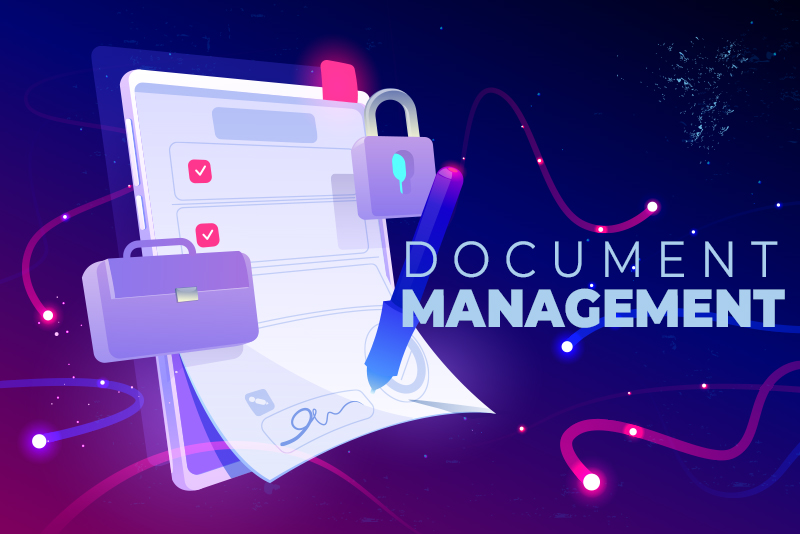The electronic document management system market is growing at a rapid pace. According to a recent report from Emergen Research, the global document management systems market size is expected to reach USD 14.16 billion in 2030, registering a steady CAGR of 11.2% over the forecast period. With the growing dependence on digital devices, organizations are switching to electronic documents to increase efficiency, streamline workflow and save space, time and money. Outsourcing services such as document scanning, document conversion and data cleansing play a key role in helping businesses implement document management best practices.
To stay competitive, businesses need to stay on top of industry trends. Let’s take a look at the document management trends predicted for 2023.
- Business process automation: Demand for business process automation is growing rapidly across the globe and is one of the most prominent document management trends. Data is at the core of digital operations. To adopt artificial intelligence, machine learning, natural language processing, and other cutting-edge technologies, forward thinking organizations are and automating data management across different environments. Automated processes are reliable, adaptable, efficient, and scalable, and can make industries resilient to disruptions like the COVID-19 pandemic. Intelligent Automation platform Workato’s Work Automation Index studied how 900 companies used automation over a one year period, and found that more and more teams are adopting automation. According to Workato, the percentage of organizations that have at least 7 departments automating is growing at 33% year-over-year, and that if this growth rate remains unchanged, more than a third of companies will be in that top tier within the first few months of 2023.
- Increased use of cloud storage: As more and more organizations move their data and applications to the cloud, the dependency on cloud-based services will continue to increase. Moving to the cloud allows organizations to deploy data-intensive applications that drive business analytics, gain valuable insights from the information, and make data-driven decisions. Cloud services make it possible to access and share critical documents for strategic business decision-making, a property that enabled cloud service adopters to sync with new remote working norms much quicker and more efficiently during the COVID-19 pandemic. With reports predicting that the future of work is hybrid, the cloud will become indispensable to keep teams connected.
- Increased adoption of Artificial Intelligence (AI): According to the IBM Global Adoption Index, the global AI adoption rate grew steadily and reached 35% in 2022, a four-point increase from the year before. AI helps companies address labor and skills shortage by automating repetitive tasks like data collection and data processing. AI has the ability to understand the semantics of content and automatically acquire knowledge. It leverages intelligent document processing (IDP) to automate data extraction from unstructured and semi-structured documents and convert it into structured and usable data with high accuracy. More and more companies are also using AI to address their sustainability goals. According to Fortune Business Insights, the global AI market size is expected to reach USD 1394.30 billion in 2029, expanding at a CAGR of 20.1% during the forecast period, 2022-2029.
- Blockchain adoption: As discussed above, document digitization, cloud storage and AI allow organizations to automate a large part of the work processes and manage their data safely and efficiently. Block chain is also supporting these document management trends. In a blockchain based filing system, it is possible to verify a document’s location, its creator and when it was modified, so any attempt to manipulate it can be detected. Block chain prevents the common problem of document duplication, allows documents to be circulated and tracked easily and securely, and accelerates transaction validation. Blockchain supports document management across many industries – legal, accounting finance, and insurance, logistics, energy and infrastructure, healthcare, e-commerce and retail, telecommunications, and real estate (www.blockchain.oodles.io).
- Federated document management: Not being able to find and use information quickly is a key challenge for information management, costing money and decreasing efficiency. Price Waterhouse Coopers estimated that it costs approximately $20 to file a document and $120 to retrieve it, while taking a worker an average 18 minutes to look for it. At this rate, the annual costs of locating and retrieving information effectively would be very high for organizations employing 1000 knowledge workers. Federated document management integrates multiple repositories and leverages the latest cutting edge technology to offer native, in-place, document management processing capabilities.
- Global stakeholder engagement and collaboration: The importance of document collaboration software became significant during the pandemic. Collaboration tools streamline document workflow, allowing employees to access business documents seamlessly and work remotely. In 2023 and beyond, the focus will be on global document management systems that enable stakeholders, such as vendors and suppliers and others, in different parts of the world to share documents and collaborate securely.
- Improving customer service: With the need for customer-centric strategies to create a better customer experience and drive growth, companies will look to document management systems to meet this need. Organizing documents in a structured, controlled management system and automating business processes will enable companies to access real-time information, quickly answer customer queries, track their orders, and share data, while keeping customer information safe.
To fuel digital business operations and experience data-driven success, organizations need to have good data. That’s where outsourcing services come to the rescue. Partnering with a technologically advanced document conversion company is the best way to embrace the latest document management trends and stay competitive in 2023 and beyond.




